In the world of music, and especially in piano playing, the term ‘interval’ carries a significant meaning. In piano, an interval denotes the pitch distance between two notes. Whether you are a seasoned pianist or just beginning your journey, understanding intervals is fundamental to identifying and playing scales, chords, and melodies. It’s the backbone of harmony and the DNA of melody in the realm of piano music. Let’s delve into more detail to unfold the complex, yet fascinating concept of intervals in piano.
What Are Intervals On The Piano?
Intervals on the piano can be thought of as the steps between notes. Musical notes are quantified by the variation in pitch from one note to another. Intervals can range from a half step, known as a semitone (the smallest possible interval in Western music, like the step from C to C sharp), to multiple octaves. Each interval has a unique sound, and different intervals are used to create different types of scales and chords. Understanding these intervals is integral to understanding the structure and composition of music.
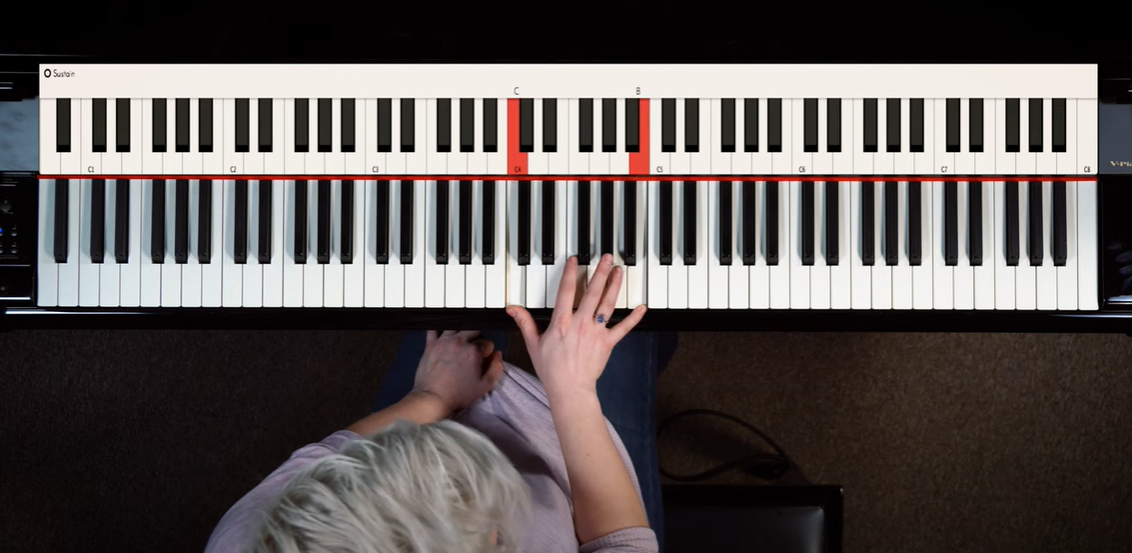
How Do You Count Intervals In Music?
To count intervals in music, you start with the root note as one, and then each subsequent note on the scale represents the next number. For example, if we start with C as the root note, C is 1, D is 2, E is 3, and so on. If you’re counting an interval from C to E, it would be a third because E is the third note from C in the scale. The key to counting intervals is remembering to count both the first and last note of the interval. It’s also crucial to remember that the count is based on the diatonic scale (the major or minor scale), not the chromatic scale (which includes all the half steps). [1]
How Do You Find Intervals On A Piano?
To determine intervals on a piano, begin with a designated note called the root note, and then ascend or descend the keyboard to reach another note. The number of keys (both white and black) you cross, including the starting and ending notes, determines the size of the interval, measured in semitones or half steps. For example, if you start at C and move to D, you’ve traversed a whole step or tone, which is equivalent to two semitones or half steps. When transitioning from C to C sharp in Western music, you are making a move of half step or semitone, which represents the smallest interval. Therefore, by calculating the distance in steps between two notes, one can determine the interval.
Major And Minor Piano Intervals
Major and minor intervals stand as fundamental concepts in music theory and piano playing, shaping the very essence of musical understanding and expression. Major intervals create a happy or bright sound, while minor intervals create a sad or dark sound. This contrast forms the basis of a lot of Western music.
Minor Intervals: Minor intervals, on the other hand, are derived from the natural minor scale. They are the minor second (2nd), minor third (3rd), minor sixth (6th), and minor seventh (7th). For instance, in the A minor scale, the interval from A to B is a minor 2nd, A to C is a minor 3rd, A to F is a minor 6th, and A to G is a minor 7th.
By understanding major and minor intervals, you can construct and identify many different kinds of scales and chords, enhancing your versatility as a pianist. [2]
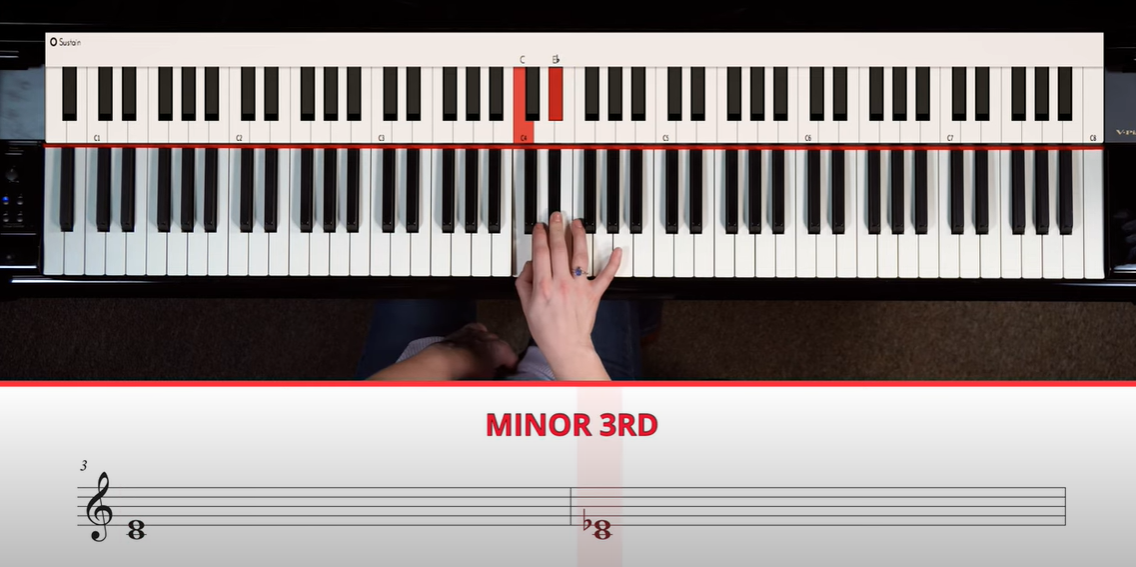
Harmonic And Melodic Piano Intervals
Understanding piano intervals requires knowledge of both harmonic and melodic intervals, as they play a pivotal role in music theory.
Harmonic Piano Intervals: Harmonic intervals arise when two notes are played simultaneously, creating a harmonious blend of sound. Put simply, it refers to the variation in pitch between two simultaneous notes. They form the building blocks of chords and harmony in music. For a simple example, if you were to play the C and E notes together on a piano, you would be playing a harmonic interval (specifically, a major third).
Melodic Piano Intervals: On the other hand, melodic intervals consist of two notes played in sequence, one after the other. They are the steps between notes in a melody. If you play the C note and then the E note on a piano, you are playing a melodic interval (again, a major third).
A solid grasp of harmonic and melodic intervals is vital for creating and identifying melodies and harmonies, both of which are fundamental to music composition and interpretation, especially in piano playing.
Types Of Piano Intervals
In piano music, intervals are categorized into two broad categories: simple and compound intervals.
Simple intervals are those within an octave (from unison to octave). They include:
- Unison (Perfect 1st): When two notes with identical pitches are played together.
- Minor 2nd: The smallest interval in piano music such as the step from C to C#.
- Major 2nd: A whole step, such as the step from C to D.
- Minor 3rd: Derived from minor scales, for instance, the distance from A to C in A minor scale.
- Major 3rd: An interval refers to the distance between a note and the third note above it in a major scale. For example, in the C major scale, the interval from C to E.
- Perfect 4th: Four steps up from a given note, as in from C to F in a C major scale.
- Tritone: For instance, the interval between C and F# can be described as an augmented fourth or a diminished fifth.
- Perfect 5th: Five steps up from a given note, for instance, C to G in a C major scale.
- Minor 6th: An interval from a note to the sixth note above it in a minor scale, such as from A to F in A minor scale.
- Major 6th: Six steps up from a given note in a major scale, like from C to A in C major scale.
- Minor 7th: Derived from minor scales, for example, the distance from A to G in A minor scale.
- Major 7th: An interval from a note to the seventh note above it in a major scale, like the distance from C to B in C major scale.
- Perfect Octave (Perfect 8th): Eight steps up from a given note, which will always be the same note but at a higher pitch, like from C to the next C. [3]
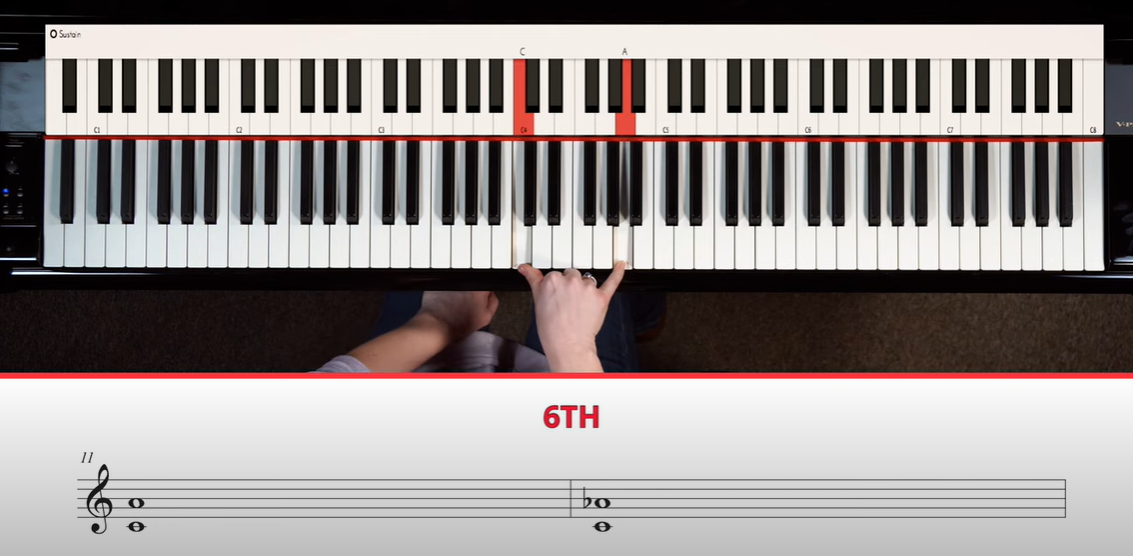
Compound Intervals
Compound intervals are intervals that exceed an octave in size. They can be derived by adding an octave to a simple interval. For instance, a ninth is an octave plus a second, a tenth is an octave plus a third, and so on. These intervals are often found in advanced piano pieces and have a distinct, complex sound that can add depth and richness to the music.
By understanding and mastering these intervals, pianists can increase their ability to play scales, chords, and melodies more proficiently. It’s crucial for developing the skills to both interpret and compose music.
Piano Interval Inversion
An important concept in understanding piano intervals is the idea of inversion. An interval is inverted when the lower note is shifted to an octave above, making it the higher note. In other words, the note that was initially on the bottom of the interval is now on the top. The fascinating aspect of interval inversions is that specific intervals always invert into specific other intervals. As an example, a major interval can be transformed into a minor interval, while a minor interval can be transformed into a major one. Likewise, a perfect interval will invert into another perfect interval. By comprehending the concept of interval inversion, pianists can further expand their understanding of the relationship between different notes and the effects they produce when played together, thereby enhancing their musical repertoire. [4]
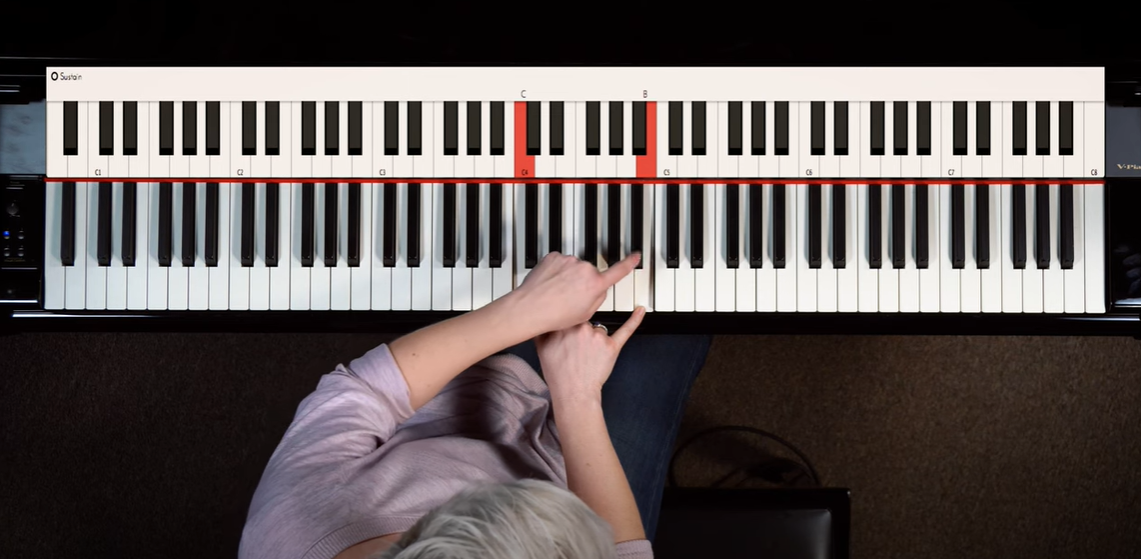
Intervals At The Piano Keyboard
When looking at the piano keyboard, it becomes easier to understand and visualize intervals. Each consecutive key on the piano, including both black and white keys, represents a half step, or minor 2nd interval. For example, the interval from C to C# or from E to F is a minor 2nd. A major 2nd interval, such as from C to D or from E to F#, spans two half steps. The keys on the piano are arranged in such a way that every octave contains 12 half steps or minor 2nd intervals, and these 12 keys repeat across the full range of the keyboard. Therefore, a perfect octave interval (or perfect 8th) can be envisioned as the distance between one C key and the adjacent C key on the keyboard, whether ascending or descending. By acquiring the skill to identify and perform intervals on the keyboard, pianists can elevate their capacity to discern harmonic connections, play by ear, and engage in improvisation.
The Summing Up Intervals
Understanding piano intervals is a fundamental aspect of learning and mastering the piano. These intervals, which are the stepping stones of melody and harmony, are categorized into harmonic, melodic, simple, and compound intervals, each with its unique characteristics. Simple intervals range from unison to octave, while compound intervals are larger than an octave. The concept of interval inversion gives pianists a deeper understanding of the relationship between different notes. By visualizing these intervals on the piano keyboard, the concepts become even more concrete, elevating our capacity to perceive harmonic relationships, play by ear, and engage in improvisation. With a solid foundation in piano intervals, pianists can explore the vast landscape of music with increased confidence and proficiency. [5]
The Definition Of Triads
Triads in music represent a specific type of chord, formed by three notes that are played simultaneously. A chord grouping typically comprises a fundamental note, known as the root, accompanied by two additional notes: the third and the fifth, which are layered above it. The triad’s type is determined by the intervals between its notes. There are four primary types of triads: major, minor, diminished, and augmented.
- Major Triad: The major triad is a three-note chord comprising a root, major third, and perfect fifth. In the C major triad, the notes are C (root), E (major third), and G (perfect fifth).
- Minor Triad: A minor triad is made up of three notes: a root, a minor third, and a perfect fifth. For example, if we consider a C minor triad, the notes would be C (as the root), Eb (as the minor third), and G (as the perfect fifth).
- Diminished Triad: The diminished triad consists of a root, a minor third, and a diminished fifth. For example, in the C diminished triad, you would play C as the root, Eb as the minor third, and Gb as the diminished fifth.
- Augmented Triad: An augmented triad consists of a root, major third, and augmented fifth. For instance, in the C augmented triad, the notes are C (root), E (major third), and G# (augmented fifth). [5]
Understanding and mastering triads is crucial for any pianist, providing the basis for chord progression and harmony in many pieces of music.
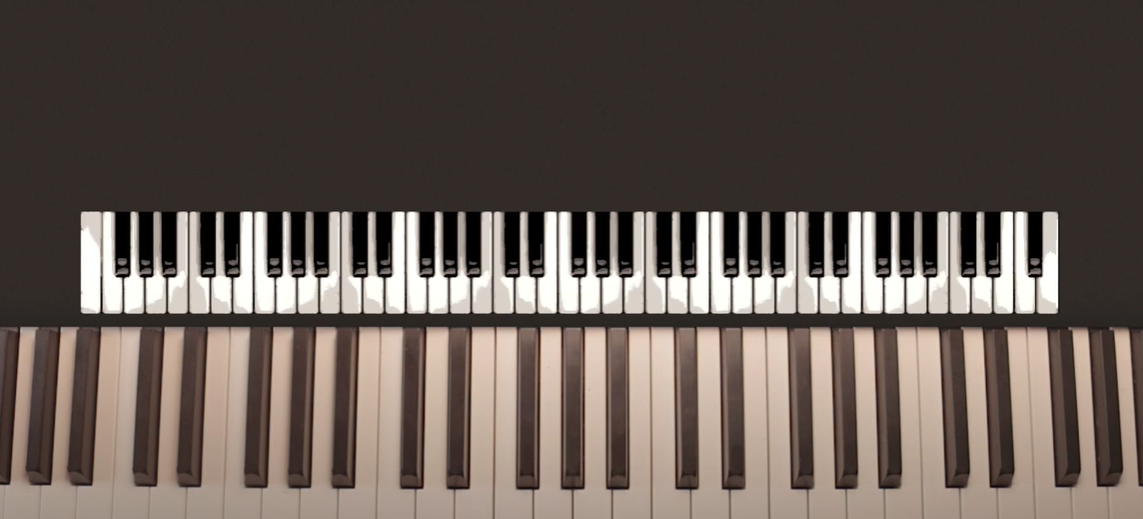
Why Are Intervals Important In Piano?
Intervals play a pivotal role in piano playing and in music broadly. They are the building blocks of scales and chords, which form the foundation of music theory. Each interval has a distinct sound that imparts specific emotional qualities to a piece of music, enabling musicians to create a wide range of moods and expressions. Moreover, understanding intervals aids in sight-reading proficiency, as it allows players to recognize patterns and predict the movement of melodies and harmonies. It also improves aural skills, enabling pianists to identify and reproduce intervals by ear, which is essential for playing music without the aid of written scores. Furthermore, the notion of intervals is intimately involved in composing music, as composers employ them to construct melodies, develop harmonic structures, and design chord progressions. Therefore, a strong understanding of intervals is vital for both performing and creating music. [6]
FAQ
What is an example of an interval on a piano?
An example of an interval on a piano is the “Perfect Fifth.” This interval is often described as having a strong, pleasing sound. On a piano, if you begin on middle C (commonly marked on keyboards and also known as C4) and count up five white keys (C-D-E-F-G), you will reach G. The distance from C to G is a Perfect Fifth. Another example is a “Major Third” interval. Start on C and count three white keys (C-D-E), you will reach E. So, the interval from C to E is a Major Third. These are just two examples of the many possible intervals on a piano, each with their own unique sound and feel.
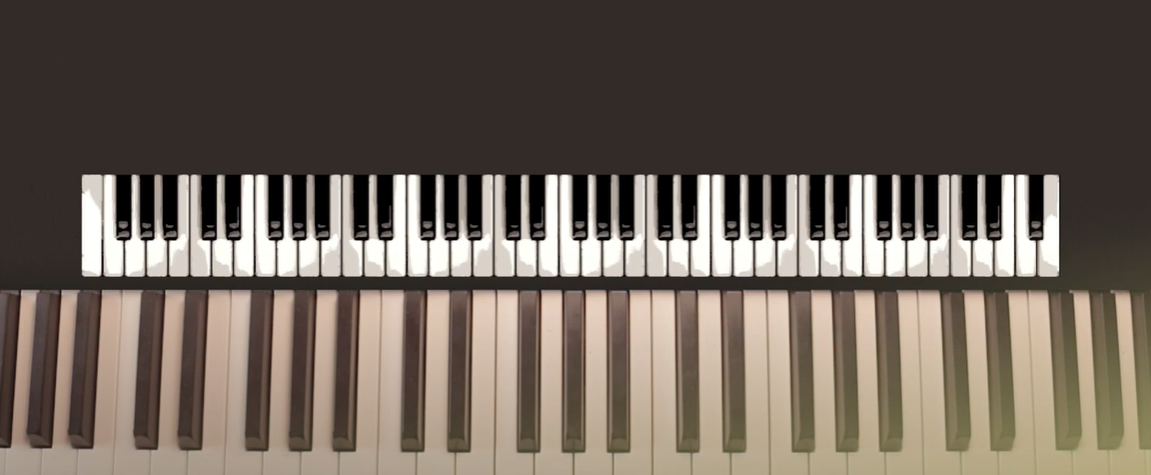
How do you identify intervals on a piano?
Identifying intervals on a piano is a process that involves a combination of visual recognition, auditory perception, and knowledge of music theory. First, look at the keys involved in the interval. The distance between the keys can give you a general idea of the interval’s size. For instance, notes that are next to each other on the keyboard are a second apart, while notes with another key in between them are a third apart. Second, listen to the sound of the interval. Each interval has a distinct sound that can be memorized and recognized through ear training. A major third, for instance, has a bright and happy sound, whereas a minor third has a darker, sadder sound. Finally, compare the keys to a known scale to determine the exact type of the interval. For example, if the interval matches the first and third notes of the C major scale, it’s a major third.
What does interval mean in music?
In music, an interval refers to the distance in pitch between two notes. It is one of the most fundamental aspects of music theory, serving as the building blocks for melodies, harmonies, and chords. Intervals can vary in size from the smallest measurable distance in Western music (a half-step or semitone) to several octaves. Each interval possesses its unique tonal character, contributing to the overall mood and feel of a piece of music. Understanding and recognizing intervals is crucial for musicians as it aids in sight-reading, improvisation, composition, and developing a comprehensive understanding of music structure and theory.
How many intervals are there in piano?
On a piano, technically, there are twelve distinct intervals within an octave, from a minor second (or semitone) through to a perfect octave. These are: minor second, major second, minor third, major third, perfect fourth, tritone (or diminished fifth or augmented fourth), perfect fifth, minor sixth, major sixth, minor seventh, major seventh, and perfect octave. However, it’s crucial to note that these intervals can repeat across multiple octaves, and they can also occur starting on any note. Thus, the potential number of intervals on a full 88-key piano is vast. Understanding these intervals is a key part of music theory and piano playing, as they form the basis for melodies, scales, and chords.
Why are intervals important?
Intervals are important in piano and music in general for a multitude of reasons. Firstly, they are the key components of scales and chords, which are the foundation of musical composition and improvisation. Knowledge of intervals helps musicians understand the structure and progression of a piece, enabling them to play it with accuracy and expression. Secondly, each interval has a unique sonic character, and its understanding can enrich a musician’s interpretative palette, allowing them to convey a wide array of emotions and moods through their performance. Thirdly, fluency in intervals enhances sight-reading skills, as musicians can swiftly recognize common interval patterns on sheet music. Lastly, mastery of intervals is essential for aural training; musicians can identify and replicate intervals by ear, crucial for playing by ear and improvisation.
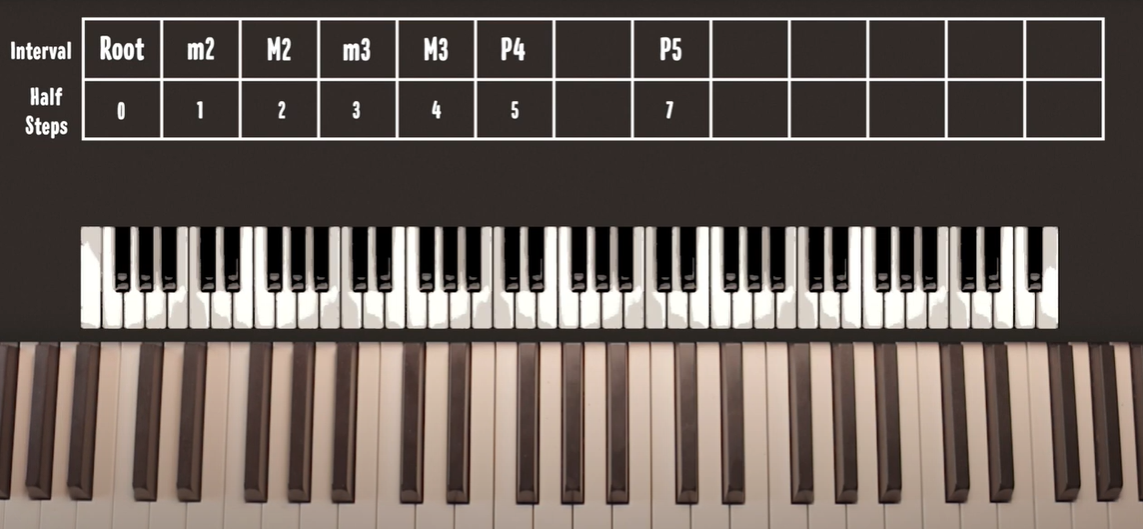
How long are piano intervals?
The length of piano intervals does not refer to a duration of time, but rather the distance in pitch between two notes. For instance, a minor second, the smallest interval, refers to the pitch difference between two keys that are next to each other on the keyboard. This is equivalent to one semitone. On the other end of the spectrum, an octave, which is the distance between one musical note and another with half or double its frequency, spans all 12 keys in the chromatic scale, both black and white. Thus, the “length” of piano intervals pertains to the pitch distance that separates two notes, and this can range from one semitone (a minor second) to several octaves.
What are interval examples?
Interval examples in music, particularly on the piano, are numerous. Let’s start with the “Major Second.” This interval is equivalent to two semitones or a whole tone. If you begin on C and move to D, you’ve formed a Major Second. Another example is the “Perfect Fourth.” Here, starting from C and moving four white keys (C-D-E-F) will bring you to F – creating a Perfect Fourth. A “Minor Seventh” interval spans 10 semitones. If you start on C and move ten keys up to land on Bb (including both white and black keys), you’ve created a Minor Seventh. Lastly, a “Perfect Octave” spans 12 semitones, or the entirety of the chromatic scale from one note to its repetition. Starting on C and moving twelve keys up (including both white and black keys) to another C forms a Perfect Octave. These are just a few examples of the variety of intervals you can form on a piano.
What is the interval in melody?
In melody, an interval refers to the pitch distance between successive notes. Melodies are essentially constructed from a series of intervals. When a melody moves from one note to the next, the pitch either ascends or descends by a certain interval. For instance, the iconic opening of Ludwig van Beethoven’s “Symphony No. 5” involves a repetition of a minor second interval. The nature of these intervals – whether they are large or small, consonant or dissonant, ascending or descending – tremendously impacts the character and mood of the melody. A melody composed of small, stepwise intervals tends to sound smooth and connected, while one with large, jumpy intervals might convey a sense of drama or tension. Consequently, understanding and manipulating intervals is a key aspect of melodic composition and interpretation.
How do I find the interval?
Finding the interval in a piece of music, specifically on the piano, involves identifying the pitch difference between two notes. Here are straightforward steps to find intervals:
- Identify the first and the second note. You’ll be determining the interval or distance between these two notes.
- Determine the number of ‘steps’ between the two notes. Each step on the piano corresponds to each key, including both white and black keys.
- Use the total number of steps to determine the interval. For instance, one step represents a minor second, while twelve steps correspond to an octave.
How do intervals sound?
Each interval has a distinctive sound that musicians learn to identify through a process of ear training. For example, a “Perfect Fourth” often sounds harmonious and stable. This can be heard in the opening two notes of the popular hymn “Amazing Grace.” On the other hand, a “Major Seventh” is considered dissonant, or tension-filled, due to its close proximity to the next octave – an interval that sounds very stable. A popular example of this interval is the first two notes in the theme from “Superman”. Furthermore, the “Perfect Octave” is generally perceived as balanced and satisfying to the ear, since it’s the same note at a higher or lower pitch. Recognizing the sounds of intervals is key to understanding and interpreting music, as well as developing skills like playing by ear and improvisation. As with many aspects of music, learning to identify intervals by ear takes practice, but with time, musicians can come to instantly recognize these sounds and their associated feelings.
Useful Video: Understanding Intervals On The Piano
Conclusion
In conclusion, intervals, the pitch difference between two notes, are a fundamental component of music theory and performance. They define the structure and character of both melody and harmony, dictating the mood and feel of a piece. From the smallest interval, a minor second, to the expansive octave, understanding and recognizing intervals are key abilities in the musician’s skillset. Whether you’re sight-reading sheet music, improvising a jazz solo, or composing a new melody, a firm grasp of intervals will enhance your musical proficiency and expression.
References:
- https://www.pianolessons.com/piano-lessons/piano-intervals.php#:~:text=What%20is%20an%20interval%2C%20you,second%20note%20in%20the%20scale.
- https://www.skoove.com/blog/understanding-piano-intervals/
- https://www.hoffmanacademy.com/blog/what-are-intervals-in-music-theory-piano-intervals-explained/
- https://www.pianote.com/blog/piano-intervals-music-theory/
- https://www.julieswihart.com/your-ultimate-guide-to-piano-intervals/
- https://vitapiano.com/the-complete-guide-to-piano-intervals/




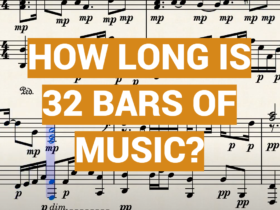
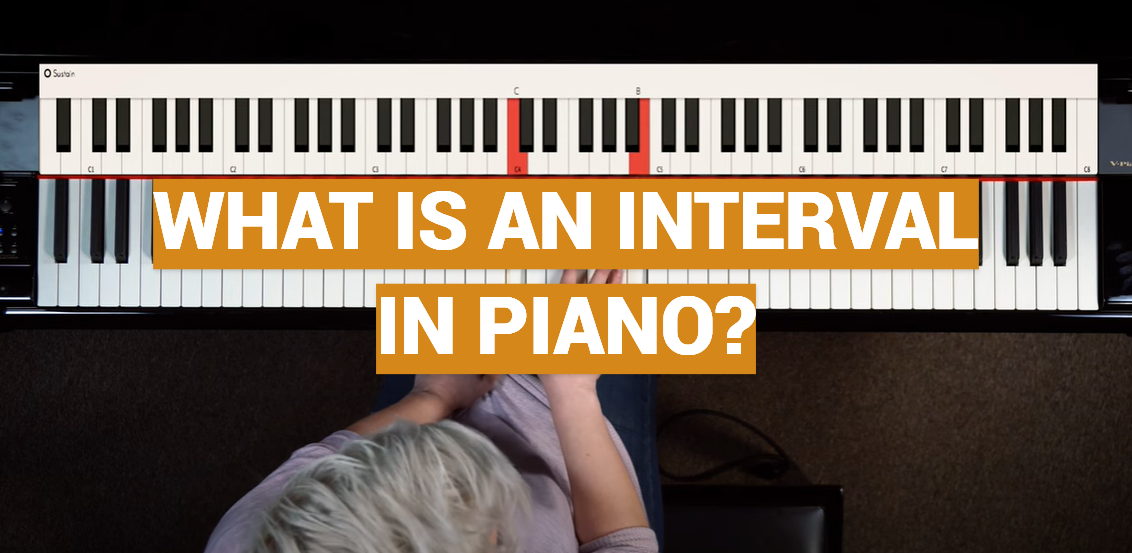




Leave a Reply